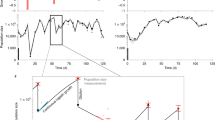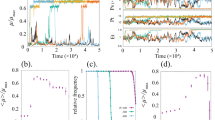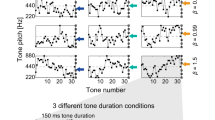Abstract
Natural habitats of some microorganisms may fluctuate erratically, whereas others, which are more predictable, offer the opportunity to prepare in advance for the next environmental change. In analogy to classical Pavlovian conditioning, microorganisms may have evolved to anticipate environmental stimuli by adapting to their temporal order of appearance. Here we present evidence for environmental change anticipation in two model microorganisms, Escherichia coli and Saccharomyces cerevisiae. We show that anticipation is an adaptive trait, because pre-exposure to the stimulus that typically appears early in the ecology improves the organism’s fitness when encountered with a second stimulus. Additionally, we observe loss of the conditioned response in E. coli strains that were repeatedly exposed in a laboratory evolution experiment only to the first stimulus. Focusing on the molecular level reveals that the natural temporal order of stimuli is embedded in the wiring of the regulatory network—early stimuli pre-induce genes that would be needed for later ones, yet later stimuli only induce genes needed to cope with them. Our work indicates that environmental anticipation is an adaptive trait that was repeatedly selected for during evolution and thus may be ubiquitous in biology.
This is a preview of subscription content, access via your institution
Access options
Subscribe to this journal
Receive 51 print issues and online access
$199.00 per year
only $3.90 per issue
Buy this article
- Purchase on Springer Link
- Instant access to full article PDF
Prices may be subject to local taxes which are calculated during checkout





Similar content being viewed by others
References
Causton, H. C. et al. Remodeling of yeast genome expression in response to environmental changes. Mol. Biol. Cell 12, 323–337 (2001)
Gasch, A. P. et al. Genomic expression programs in the response of yeast cells to environmental changes. Mol. Biol. Cell 11, 4241–4257 (2000)
Cheung, K. J. et al. A microarray-based antibiotic screen identifies a regulatory role for supercoiling in the osmotic stress response of Escherichia coli. Genome Res. 13, 206–215 (2003)
Tirosh, I., Weinberger, A., Carmi, M. & Barkai, N. A genetic signature of interspecies variations in gene expression. Nature Genet. 38, 830–834 (2006)
Kussell, E. & Leibler, S. Phenotypic diversity, population growth, and information in fluctuating environments. Science 309, 2075–2078 (2005)
Acar, M., Mettetal, J. T. & van Oudenaarden, A. Stochastic switching as a survival strategy in fluctuating environments. Nature Genet. 40, 471–475 (2008)
Balaban, N. Q. et al. Bacterial persistence as a phenotypic switch. Science 305, 1622–1625 (2004)
Pavlov, I. P. Conditioned Reflexes (Oxford Univ. Press, 1927)
Tagkopoulos, I., Liu, Y. C. & Tavazoie, S. Predictive behavior within microbial genetic networks. Science 320, 1313–1317 (2008)
Savageau, M. A. Escherichia coli habitats, cell-types, and molecular mechanisms of gene control. Am. Nat. 122, 732–744 (1983)
Savageau, M. A. Demand theory of gene regulation. II. Quantitative application to the lactose and maltose operons of Escherichia coli. Genetics 149, 1677–1691 (1998)
Zaslaver, A. et al. A comprehensive library of fluorescent transcriptional reporters for Escherichia coli. Nature Methods 3, 623–628 (2006)
Soupene, E. et al. Physiological studies of Escherichia coli strain MG1655: Growth defects and apparent cross-regulation of gene expression. J. Bacteriol. 185, 5611–5626 (2003)
Oxman, E., Alon, U. & Dekel, E. Defined order of evolutionary adaptations: experimental evidence. Evolution 62, 1547–1554 (2008)
Mortimer, R. K. Evolution and variation of the yeast (Saccharomyces) genome. Genome Res. 10, 403–409 (2000)
Sablayrolles, J. M. & Barre, P. Kinetics of alcoholic fermentation under anisothermal enological conditions. Am. J. Enol. Vitic. 44, 127–133 (1993)
Johnston, M. & Carlson, M. in The Molecular Biology of the Yeast Saccharomyces: Gene Expression (eds Jones, E. W., Pringle, J. R. & Broach, J. R.) 193–282 (Cold Spring Harbor Laboratory, 1992)
Bauer, F. F. & Pretorius, I. S. Yeast stress response and fermentation efficiency: How to survive the making of wine - a review. SAJEV 21, 27–51 (2000)
Pretorius, I. S. Tailoring wine yeast for the new millennium: novel approaches to the ancient art of winemaking. Yeast 16, 675–729 (2000)
Maris, A. F. et al. Diauxic shift-induced stress resistance against hydroperoxides in Saccharomyces cerevisiae is not an adaptive stress response and does not depend on functional mitochondria. Curr. Genet. 39, 137–149 (2001)
Sanchez, Y., Taulien, J., Borkovich, K. A. & Lindquist, S. Hsp104 is required for tolerance to many forms of stress. EMBO J. 11, 2357–2364 (1992)
Berry, D. B. & Gasch, A. P. Stress-activated genomic expression changes serve a preparative role for impending stress in yeast. Mol. Biol. Cell 19, 4580–4587 (2008)
Harris, M. A. et al. The Gene Ontology (GO) database and informatics resource. Nucleic Acids Res. 32 (Database issue). D258–D261 (2004)
Grant, C. M., MacIver, F. H. & Dawes, I. W. Mitochondrial function is required for resistance to oxidative stress in the yeast Saccharomyces cerevisiae. FEBS Lett. 410, 219–222 (1997)
Zacharioudakis, I., Gligoris, T. & Tzamarias, D. A yeast catabolic enzyme controls transcriptional memory. Curr. Biol. 17, 2041–2046 (2007)
Braun, E. & Brenner, N. Transient responses and adaptation to steady state in a eukaryotic gene regulation system. Phys. Biol. 1, 67–76 (2004)
Winzeler, E. A. et al. Functional characterization of the S. cerevisiae genome by gene deletion and parallel analysis. Science 285, 901–906 (1999)
Kaplan, S. et al. Diverse two-dimensional input functions control bacterial sugar genes. Mol. Cell 29, 786–792 (2008)
Dekel, E. & Alon, U. Optimality and evolutionary tuning of the expression level of a protein. Nature 436, 588–592 (2005)
Acknowledgements
We thank S. Trattner–Frenkel and Z. Bloom for their help and support in the yeast microarray experiments. We thank members of the Pilpel laboratory for many discussions. We thank E. Schneidman, E. Ben-Jacob, M. Springer, A. Tanay, U. Alon and D. Cavalieri for discussions and advice. We thank U. Alon for providing the promoter–GFP fused plasmids. We thank the Tauber Foundation, the Minerva Foundation, the Israel Science Foundation ‘Bikura program’, the European Research Council ‘Ideas Program’ and the Ben May Foundation for grant support. M.K. was supported from grants from the Israel Science Foundation and the Israeli Ministry of Science and Technology.
Author Contributions A.M. raised the original idea and performed all the experiments; G.R., B.G. and A.Y. participated in experiments; E.D. evolved the E. coli strain; A.M., O.D. and Y.P. designed the experiments; A.M., M.K., O.D. and Y.P. analysed the data; O.D. and Y.P. supervised the project; A.M., O.D. and Y.P. interpreted the results and wrote the manuscript.
Author information
Authors and Affiliations
Corresponding author
Supplementary information
Supplementary information
This file contains Supplementary Methods, Supplementary Tables 1-5, Supplementary Equation1, Supplementary Figures 1-8 with Legends, Supplementary Notes and Supplementary References. (PDF 324 kb)
Rights and permissions
About this article
Cite this article
Mitchell, A., Romano, G., Groisman, B. et al. Adaptive prediction of environmental changes by microorganisms. Nature 460, 220–224 (2009). https://doi.org/10.1038/nature08112
Received:
Accepted:
Published:
Issue Date:
DOI: https://doi.org/10.1038/nature08112
Comments
By submitting a comment you agree to abide by our Terms and Community Guidelines. If you find something abusive or that does not comply with our terms or guidelines please flag it as inappropriate.



